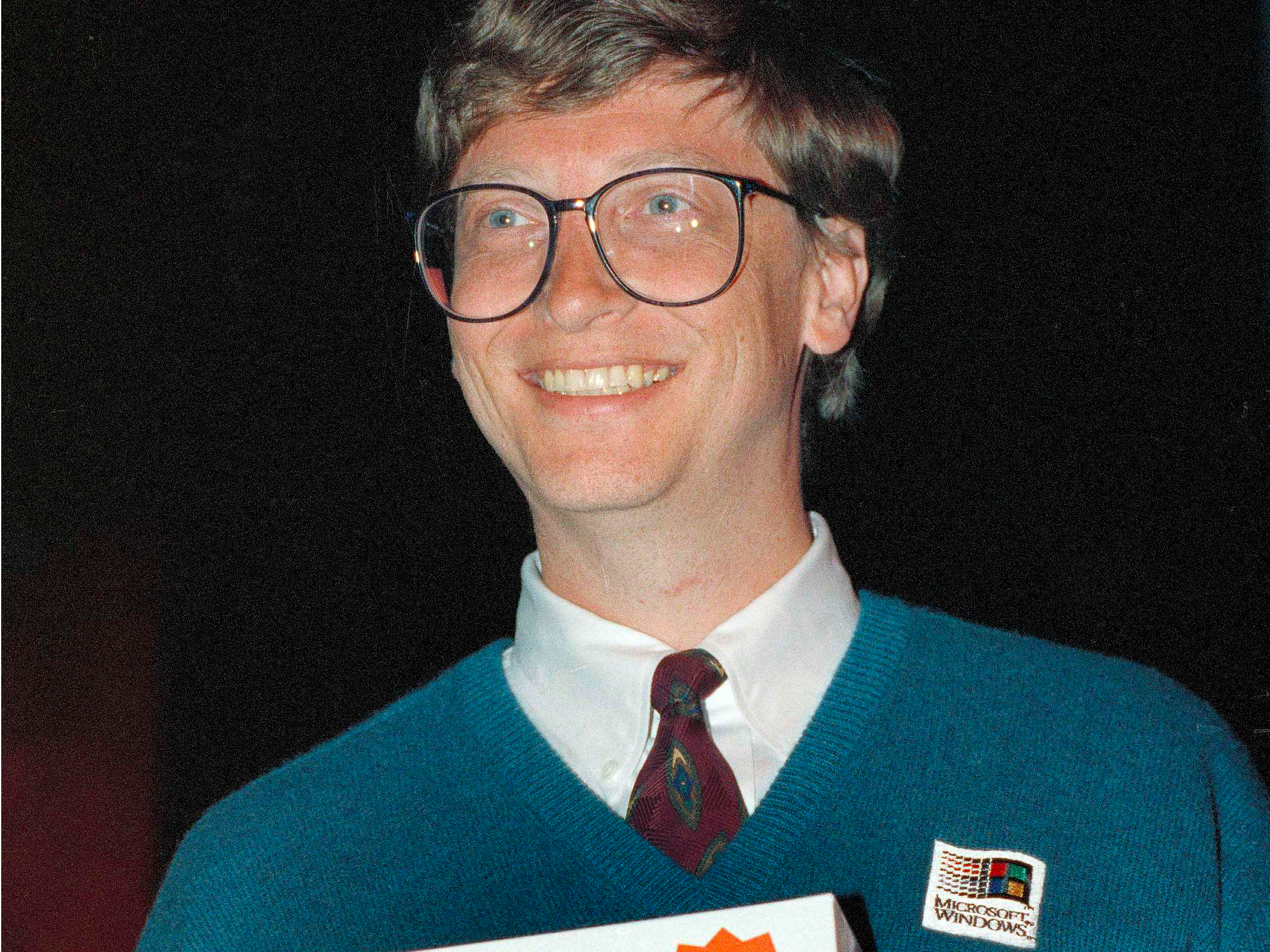With a net worth of more than $90 billion, Bill Gates is still the richest person in the world.
It wasn’t dumb luck that got him that spot – Gates is a smart, aggressive business mind who was never afraid to make enemies in his drive to take Microsoft to the top.
From Harvard dropout to an Albuquerque rental office to the top of the world, here’s how Bill Gates turned Microsoft into a global force, and became a billionaire in the process.
William Henry Gates III was born in Seattle, Washington on October 28, 1955, the son of a lawyer and a banking executive. Because of his suffix, his childhood nickname was “Trey.”

Gates’ parents were grooming him to be a lawyer. His parents enrolled him at the Lakeside School, a rigorous Seattle private high school that future Microsoft cofounder Paul Allen also attended.

But Lakeside is also where the course of Gates’ life changed. In eighth grade, the Lakeside Mothers Club used cash from a rummage sale to give students access to a Teletype Model 30 computer hooked up to the General Electric mainframe. Gates fell in love with the idea of computers.

In fact, young Gates and Allen were so enamored with computers — programming them, just seeing how they ticked — that they got themselves banned from the Computer Center Corporation mainframe after they used bugs in its code to scam free computing time.

It didn’t take long for Gates to figure out what computers could do for him. Tasked by Lakeside’s administration to help use its computers to schedule classes, he secretly organized the schedules so his classes were full of the girls he was interested in.

Before leaving Lakeside, Gates and Allen had their first business venture together: Traf-O-Data, a computer to read information from city traffic counters and feed it to traffic engineers. It was only moderately successful, but it paved the way for Microsoft.

In 1973, with a score of 1590 out of 1600 on the SAT, Gates enrolled at Harvard. But he never had a major picked out or any real plans — he just ended up spending a lot of time fooling around with the school’s computers.

Still, Gates made lots of connections at Harvard — like fellow student Steve Ballmer. They lived in the same dorm, but only met in an economics class.

In 1974, everything changed. A company called MITS released the Altair 8800 — a breakthrough PC based on the Intel 8080 processor, which made it easier than ever for hobbyists and amateurs to code software.

Gates and Allen called up MITS to ask if they would be interested in a version of the BASIC programming language for the Altair 8800. Not that Gates and Allen had ever laid hands on an Altair 8800, but they wanted to see if it was something for which they could get paid.

Gates and Allen hacked together a version of BASIC for the Altair over a few weeks and flew to the MITS offices in Albuquerque to demonstrate it. MITS was impressed enough to hire the pair — and so, they moved to New Mexico. Gates never finished his studies at Harvard.

The duo named their partnership “Micro-soft” and opened a small office in Albuquerque. By the time the company was released from its corporate overlords at MITS and incorporated in late 1976, it was just plain old “Microsoft.”

This is also around when young Gates got pulled over for a traffic violation in 1977, resulting in his famous mugshot. In 1979, the company moved to Bellevue, Washington.

In 1980, Gates’ Harvard classmate Ballmer joined up with Microsoft. By 1988, Gates was relying on Ballmer as the company’s Executive Vice President of Sales.

For most of Microsoft’s first few years, the company was focused on writing new programming languages for the very new PC market. Gates was known as a very controlling kind of CEO, personally reviewing every line of code written by its early employees.

It was in 1980 that Gates would break out as a business superstar. When IBM needed an operating system for its forthcoming PC, it turned to Microsoft.

Gates hastily arranged for Microsoft to buy a startup working on an operating system called 86-DOS, or “Disk Operating System.” It renamed the software to PC DOS and sold it to IBM for $50,000…

…but IBM didn’t ask for the copyright to the software, and Gates never offered. It meant that Microsoft was free to sell MS-DOS, its own version of the operating system.

The success of the IBM PC inspired other tech companies to build their own personal computers, compatible with IBM’s programs. To do that, they would need to deal with Gates and Microsoft.

It set the tone for the rest of Microsoft’s growth. IBM, Compaq, Dell, and everybody else raced to build the computers — but they all needed DOS, and later, Windows software for the machines to work. It made Microsoft the center of the so-called PC revolution.

In 1983, Microsoft did $55 million in sales, making it the biggest company in the computer business. On March 13, 1986, Microsoft went public at $21 per share, getting up to $28 by the end of the first day. Gates was a billionaire by 1987, at age 31.

Thanks to his shares in Microsoft, Gates was named as the world’s richest person for the first time in 1995, and held the title until 2007. He won back the title in 2009, and then again in 2014 through the present, though Amazon’s CEO Jeff Bezos had taken the title briefly from him in late October 2017.

Windows 1.0, first released in 1985, was also the beginning of Gates’ longtime rivalry with Apple cofounder Steve Jobs. Jobs claimed that Microsoft stole the concept of a windowed, graphical user interface from Apple, and sued for copyright infringement. Microsoft won the case in 1993.

Gates is known as a competitive kind of guy — he doesn’t like to lose. Under his leadership, Microsoft got very aggressive about using the popularity of Windows to push its growing library of other software, especially Office. Windows and Office ended up conquering the lucrative business PC market.

Even internally, Gates was known to verbally spar with his executives, forcing them to defend their decisions. He would routinely interrupt meetings with quips like “That’s the stupidest thing I’ve ever heard!”

Despite being the only real alternative to Microsoft’s dominance, even Apple couldn’t keep the competition up for long. When Steve Jobs came back to Apple as CEO in 1997, he had no choice but to have his rival Gates appear on screen to announce that Microsoft made a company-saving $150 million investment in Apple — to boos from the audience.

And his aggression didn’t make Gates many fans in the techie world: Early memes like this one, portraying Gates as one of Star Trek’s dreaded Borg, were common.

Still, despite his famed long-term vision, Gates didn’t get everything right. The hardcover version of his 1995 book “The Road Ahead” discounted the potential of the Internet — a position he fixed and addressed when it went to paperback.

And in 1998, Gates’ aggressive stance got the company into a lot of trouble when the United States brought an antitrust case against Microsoft. It was resolved a few years later, with Microsoft agreeing to reform some of its business practices but escaping a potential break-up of the company.

In 2000, Gates decided to step aside and name Ballmer — by this point, the President of Microsoft — the new CEO, while he took a new role as Chief Software Architect. He still remained the face of the company, but he was done as a business leader.

In fact, Ballmer and Gates would routinely star in ridiculous “comedy” videos intended for Microsoft employees. Like this “Austin Powers” parody.

You can watch the whole spectacle here.
In 2006, Gates stepped aside as Chief Software Architect, announcing that while he’d stay at Microsoft part-time as Chairman, he’d be focusing on the Bill and Melinda Gates Foundation — the largest private charitable organization in the world, managed by Gates, his wife, and the famed investor Warren Buffett.

Since then Gates has focused his massive wealth and influence on solving big problems like access to clean water in the developing world, sustainable energy, and world hunger.

Plus, Gates keeps busy managing personal investments, like his stake in the Four Seasons hotel chain.

By the end of Steve Jobs’ life, he wasn’t exactly friends with Bill Gates, but they had largely come to terms.

Read more about their relationship here.
Despite giving away billions in charitable donations, Bill Gates is estimated to have a personal net worth of more than $90.2 billion.

And in 2014, Gates decided to step down as Chairman of Microsoft, taking a new role as Technology Advisor to Ballmer's successor, Satya Nadella. And the rest, as they say, is history.


